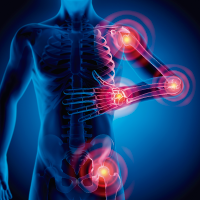Understanding Arthritis: Causes, Types, Symptoms, and Management
Arthritis is a common condition that affects millions of people worldwide. It is characterized by inflammation and pain in the joints and can significantly impact a person’s quality of life. In this article, we will explore the causes, types, symptoms, and management of arthritis.
What is Arthritis?
Arthritis refers to a group of more than 100 different joint diseases that cause inflammation, pain, stiffness, and swelling in the affected joints. It can affect people of all ages, genders, and backgrounds. The most common form of arthritis is osteoarthritis, followed by rheumatoid arthritis.
Causes of Arthritis
The causes of arthritis can vary depending on the type, but some common factors include:
Age: Osteoarthritis is more common with age, as wear and tear on the joints over time can lead to joint damage.
Genetics: Some types of arthritis, such as rheumatoid arthritis, have a genetic component, meaning they can run in families.
Autoimmune Disorders: In cases like rheumatoid arthritis, the body’s immune system mistakenly attacks healthy joint tissues, leading to inflammation.
Infections: Certain infections can trigger inflammatory forms of arthritis.
Joint Injuries: Trauma or injuries to the joints can increase the risk of developing arthritis in those joints.
Types of Arthritis
There are many different types of arthritis, but some of the most common include:
Osteoarthritis (OA): This is the most common form of arthritis and is often associated with aging and wear and tear on the joints.
Rheumatoid Arthritis (RA): An autoimmune disease in which the immune system attacks the joints, causing inflammation and pain.
Psoriatic Arthritis: A type of arthritis that often occurs in individuals with psoriasis, a skin condition.
Ankylosing Spondylitis: A form of arthritis that primarily affects the spine and sacroiliac joints.
Juvenile Arthritis: Arthritis that occurs in children and adolescents, with various subtypes.
Symptoms of Arthritis
The symptoms of arthritis can vary, but common ones include:
- Joint pain and tenderness
- Joint swelling
- Stiffness, especially in the morning or after periods of inactivity
- Reduced range of motion
- Warmth and redness around affected joints
- Fatigue
- Muscle weakness
Management and Treatment
The management of arthritis depends on the type and severity of the condition, but some general approaches include:
Medications: Nonsteroidal anti-inflammatory drugs (NSAIDs), disease-modifying antirheumatic drugs (DMARDs), and pain relievers may be prescribed to manage symptoms and slow disease progression.
Physical Therapy: Physical therapy can help improve joint function, reduce pain, and increase strength and flexibility.
Lifestyle Modifications: Maintaining a healthy weight, staying physically active, and managing stress can all help alleviate arthritis symptoms.
Assistive Devices: The use of assistive devices such as braces, splints, or canes can provide support to affected joints.
Surgery: In severe cases, joint replacement surgery may be necessary to alleviate pain and improve joint function.
Living with Arthritis
Living with arthritis can be challenging, but with the right management and support, individuals can lead fulfilling lives. Support groups, counseling, and self-care practices can help individuals cope with the emotional and physical challenges of arthritis.
Arthritis is a common condition that affects the joints, causing pain and inflammation. There are various types of arthritis, each with its causes and symptoms. Management and treatment options are available to help individuals manage their symptoms and improve their quality of life.
If you or someone you know is experiencing symptoms of arthritis, it’s essential to consult with a healthcare provider for a proper diagnosis and treatment plan tailored to your specific needs.



